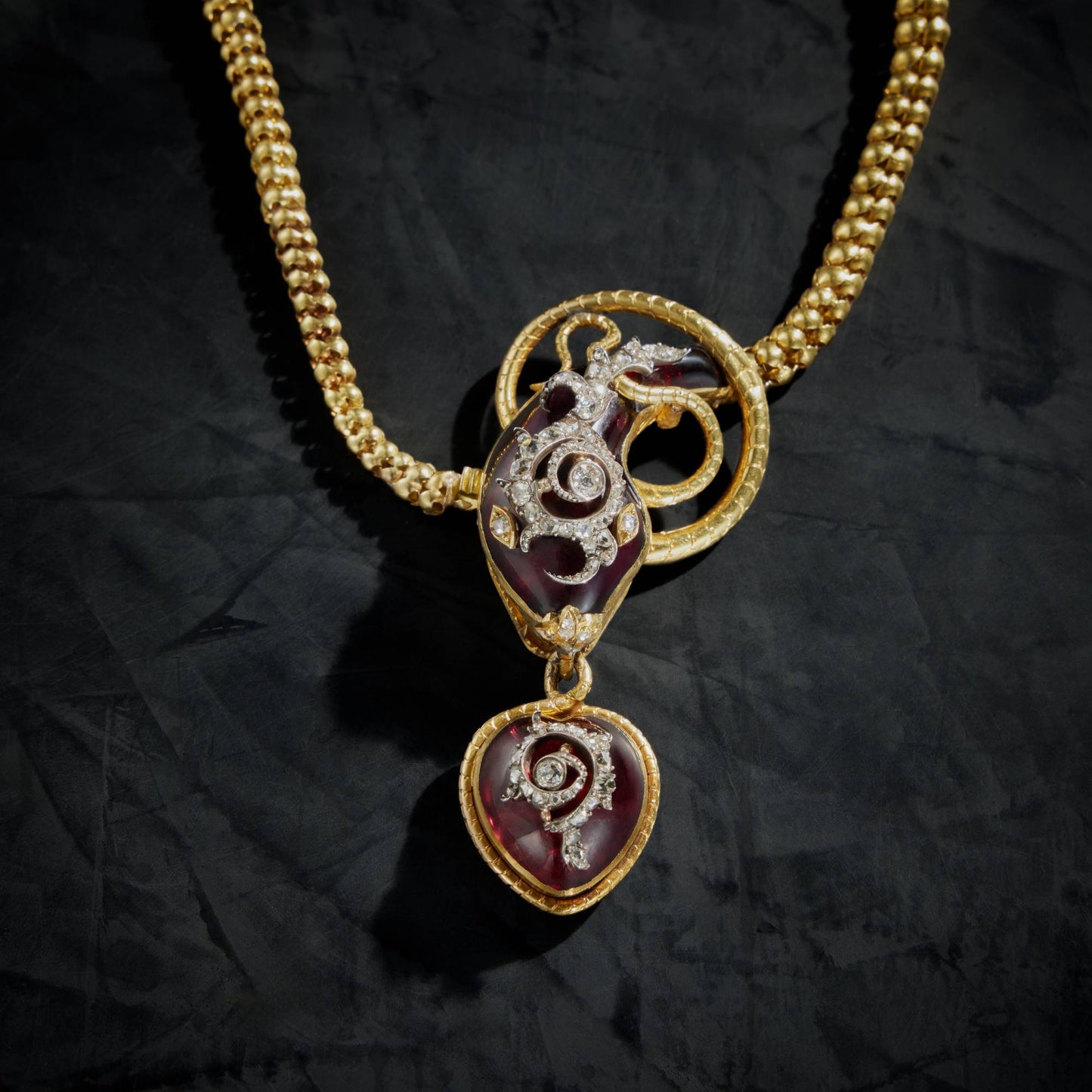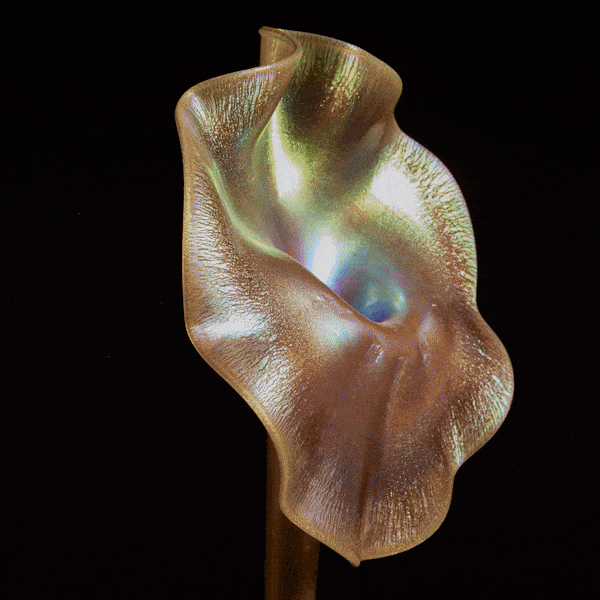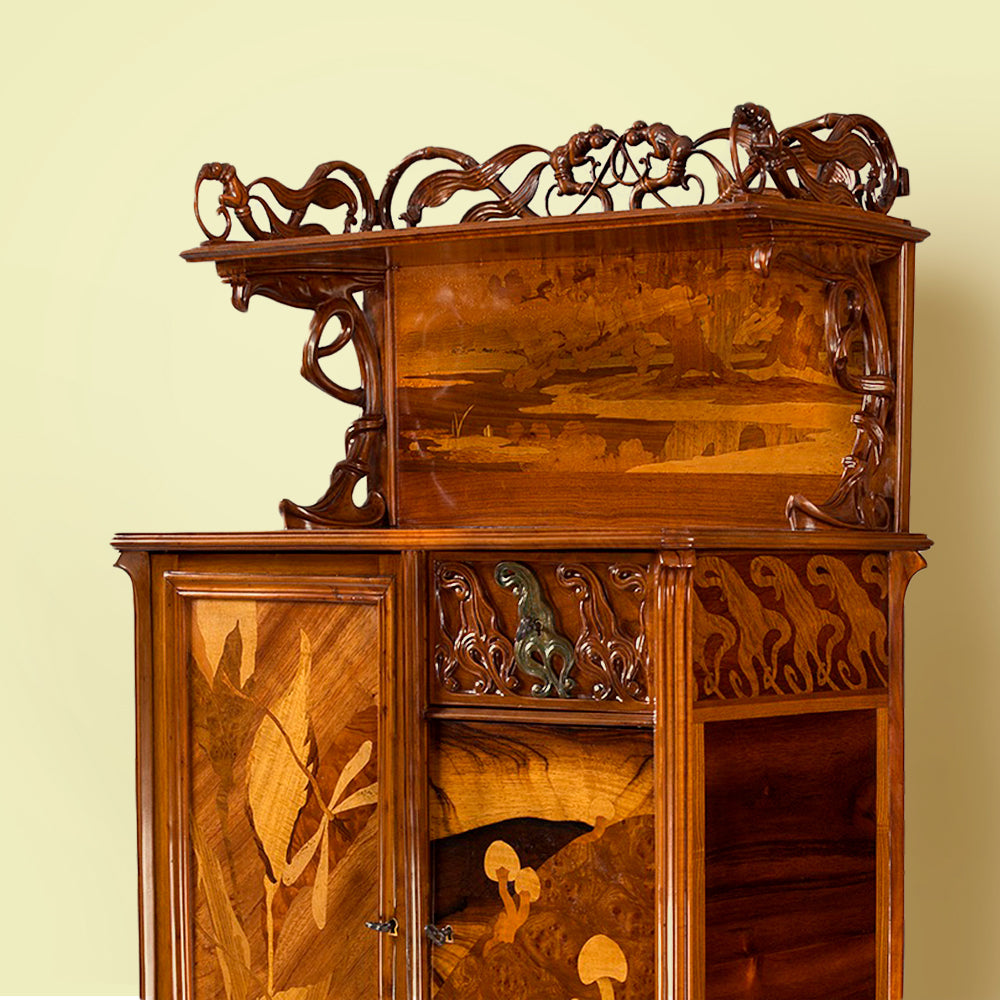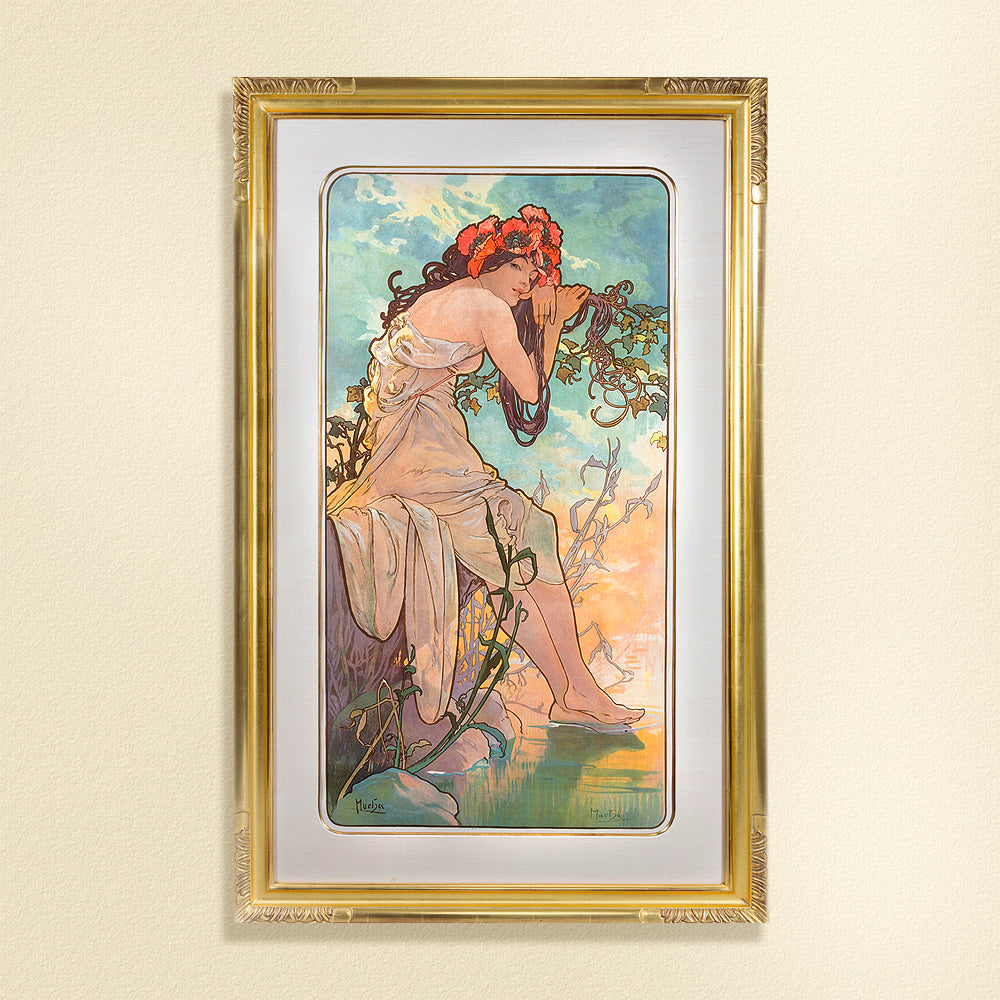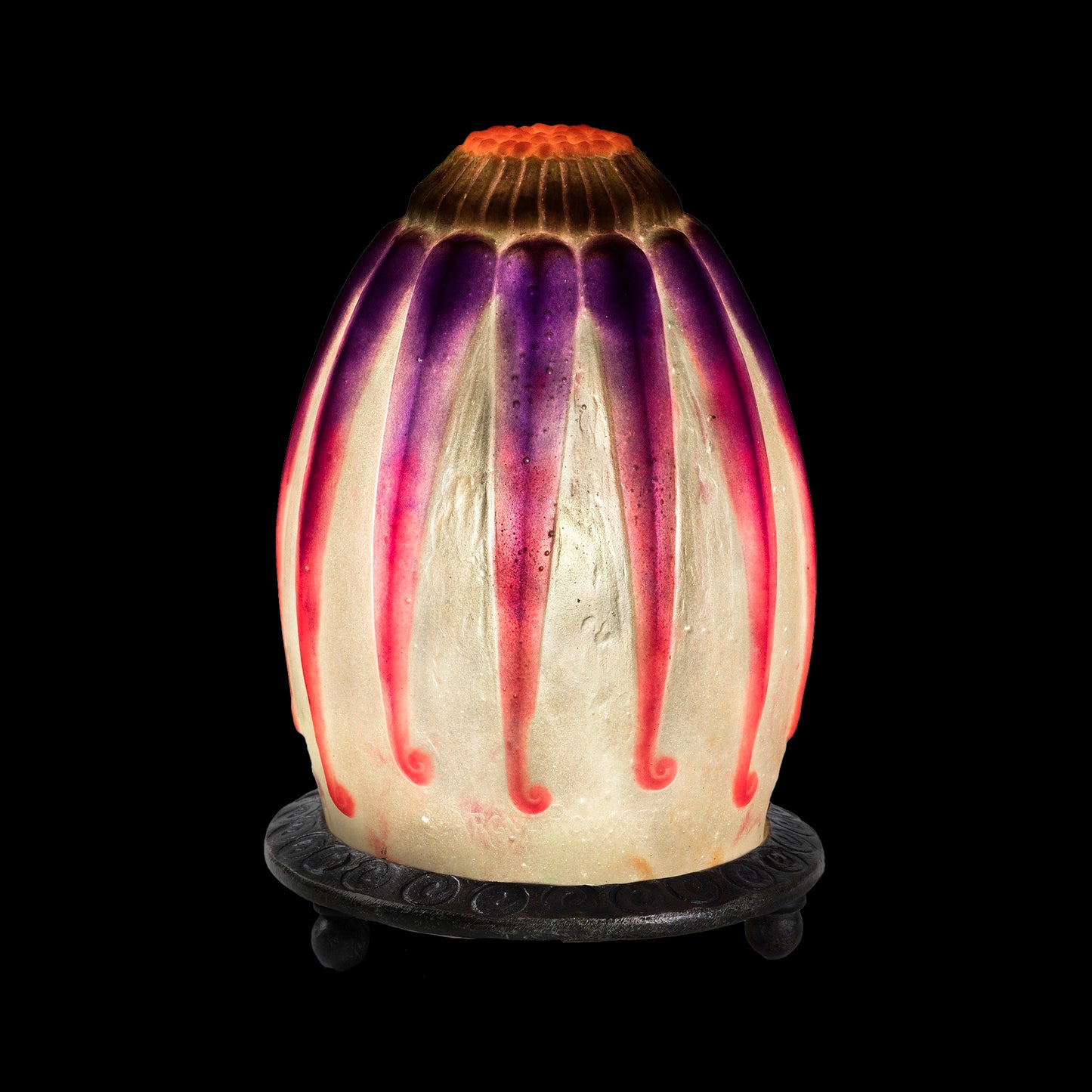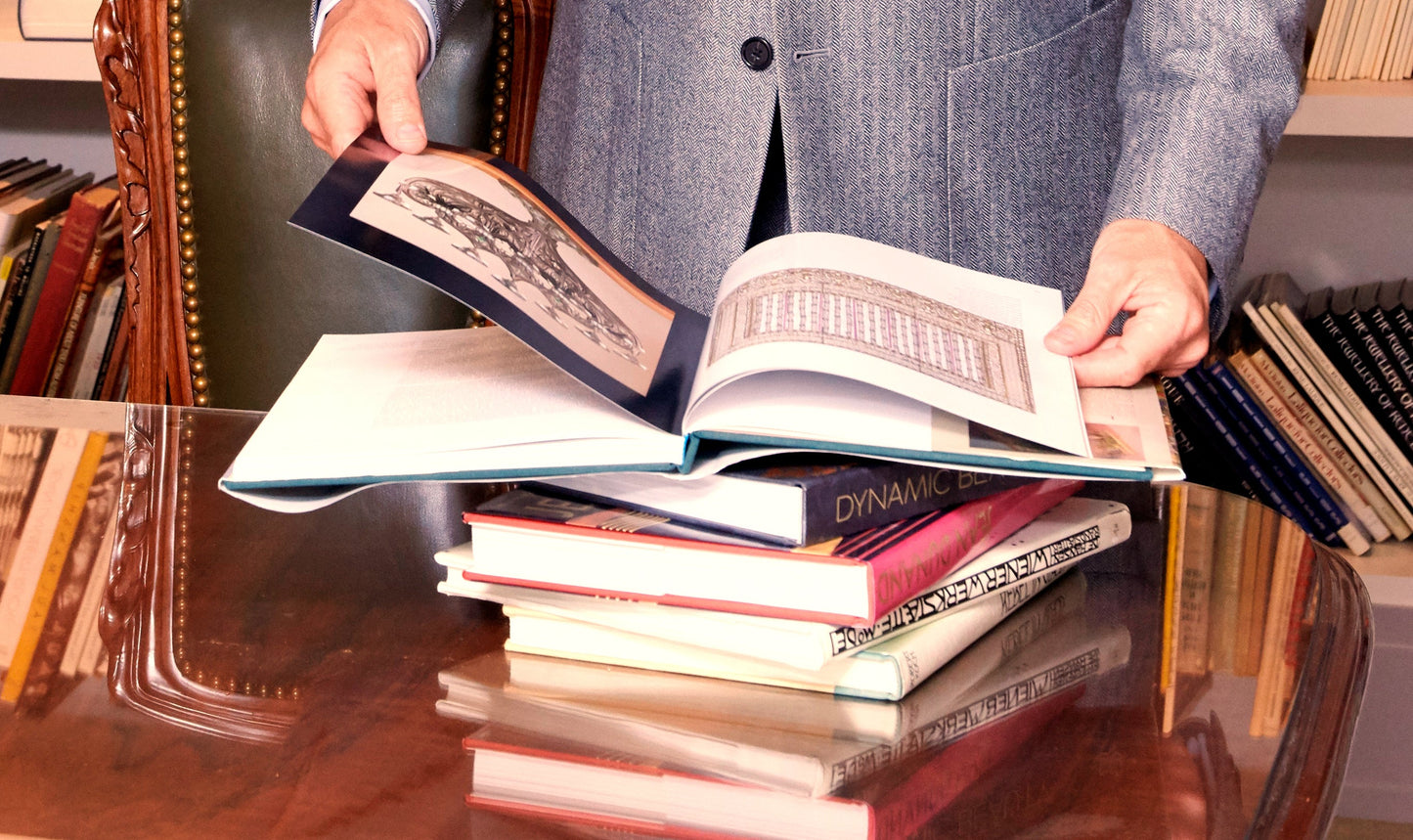
Gismonda, 1894
Alphonse Mucha’s first and perhaps most famous poster, this iconic "Gismonda" lithograph would launch both the artist’s career and his very lucrative seven year contract with the famed actress Sarah Bernhardt, who is pictured here. The stunning image, executed in exacting, graphic linear detail and richly saturated tones, features Bernhardt, dressed lushly in elaborate Catholic vestments against a backdrop of Byzantine mosaic, in her eponymous role as Gismonda in the Greek melodrama of the same name. The plot of Gismonda centers on the widowed Duchess of Athens, who vows to marry the man who saves her son from a tiger attack after he falls into a pit. When the people of Athens insist she honor this vow as a sacred promise to God, she initially agrees—until she discovers the rescuer, Almerio, is a commoner. Unwilling to marry beneath her station, she instead offers him a barony and wealth. In response to her broken vow, divine retribution descends upon Athens in the form of floods, cholera, and rampant piracy.

Atelier Nadar, 1894, Gismonda, Paris : Théâtre de la Renaissance, Bibliothèque nationale de France
As the play unfolds, Gismonda gradually falls in love with Almerio and becomes his lover. She later uncovers that her admirer, Zaccaria, was behind the assassination attempt on her son, having ordered him pushed into the tiger pit. In a dramatic turn, Gismonda kills Zaccaria in retribution. In the final act, during an Easter parade, Almerio is falsely accused of Zaccaria's murder. Gismonda publicly confesses to the killing and explains her reasons. Ultimately, she marries Almerio, who is named Duke of Athens, and the people rejoice.
The true star of the poster is, without a doubt, Sarah Bernhardt’s magnificent costume, designed by her longtime collaborator, Théophile Thomas, who would remain her designer for the rest of her illustrious career. This opulent ensemble—crafted from brocaded velvet, gold-embroidered arabesques, chenille, gold lamé, and adorned with pressed glass jewel trim—embodies theatrical grandeur and sacred symbolism. Mucha’s poster captures Bernhardt in this costume during the climactic final act of the play, as her character joins a solemn Easter procession. In this sacred moment, the people of Athens, their hearts alight with devotion, carry palms in reverence of Palm Sunday. At center stage, Bernhardt appears radiant, cloaked in an exquisitely embroidered gown and flowing cloth-of-gold stole, crowned with an enchanting orchid headdress. Behind her, an aureole of divine light radiates in the form of a mesmerizing mosaic—a ringed cross shimmering with ethereal brilliance—elevating both her presence and the spiritual gravity of the scene. In her left hand she grips a rosary crucifix over her heart, and in her right hand, she holds a martyr’s palm.
Top Left: Gismonda Costume Design Illustration, Theophile Thomas, Soulis Auctions; Top Right: Gismonda Costume Design, Victoria and Albert Museum; Theophile Thomas Costumes for Gismonda, Bibliothèque nationale de France
Both Théophile Thomas and Alphonse Mucha collaborated on the typography for the play, developing a typeface that blended elements of Lombardic Capitals and Insular Majuscule. Lombardic Capitals, with their ornate, rounded uppercase forms, were traditionally used in medieval manuscripts—particularly for initial letters—distinguished by decorative flourishes and a calligraphic elegance. Insular Majuscule, on the other hand, was the script style seen in the Book of Kells, a ninth-century illuminated manuscript created at the Abbey of Kells in Ireland, now housed at Trinity College Dublin. The Book of Kells gained international recognition in the 19th century, becoming a symbol of Irish cultural heritage. Its prestige was further elevated in 1849 when Queen Victoria and Prince Albert were invited to sign it. As a cornerstone of the Celtic Revival, the manuscript inspired a wave of Victorian-era picture books and artistic works rooted in medieval illumination, with its designs widely reproduced across various media. By fusing these two typographic traditions, Thomas and Mucha created a richly ornamental and historically resonant typeface that reflected the play’s themes of myth, cultural identity, and artistic rebirth. Their typographic design for Gismonda not only honored the visual heritage of medieval and Celtic art but also helped define the visual language of the emerging Art Nouveau movement—ultimately shaping the course of decorative typography for years to come.
Left: Typography from Gismonda by Alphonse Mucha; Top Right: Typography studies by costume designer Théophile Thomas, Victoria and Albert Museum; Bottom Right (Left): Insular Majuscule from the Book of Kells; Bottom Right (Right): The Hylle Jewel, a crowned Lombardic initial "M" with Annunciation figures, late 14th century, Oxford University
Right: Sarah Bernhardt dans “Lorenzaccio”, pièce de Jean Richepin et Henri Cain, Bibliothèque nationale de France
Lorenzaccio, 1896
This striking theater poster was created by Alphonse Mucha for Lorenzaccio, a play by Alfred de Musset set in 16th-century Florence and centered on the powerful Medici family. Sarah Bernhardt starred in the titular role. The poster depicts Lorenzaccio in a moment of contemplation, weighing the decision to assassinate his cousin, Alessandro de’ Medici, who is shown besieging the city. Hovering above, a dragon symbolizes Alessandro himself; near its mouth appears the Medici coat of arms—five red balls arranged in orle (gules) on a gold field. In the bottom panel, just above the theater's name, an ornate, jewel-encrusted sword offers a visual metaphor for Lorenzaccio’s grim solution. Lorenzaccio stands in front of a pomegranate velvet set in an arch. The predominant textile motif of the Italian Renaissance was the pomegranate, introduced into the design lexicon through trade with the Ottoman Empire. Closely associated with the noble families and their courts, the pomegranate symbolized eternity, fertility, and resurrection.
Mucha approached his posters much like Italian Renaissance artists approached portraiture—as opportunities to showcase their mastery across a wide range of design disciplines, including jewelry, textiles, costume, decorative arts, furniture, and even arms and armor. The costume design for Lorenzaccio centers on the peacock—emblematic of the Art Nouveau movement and a favorite symbol of Mucha’s. The aesthetic fuses Italian Renaissance, Medieval, and 17th-century Ottoman influences. Lorenzaccio wears a doublet and cape, cinched at the waist with a girdle adorned with basse-taille enamel plaques, each bearing a portrait of a Medici. A crimson garter, tied around her hose, is finished with a gold and turquoise aigrette in the form of a peacock. Lorenzaccio wears chainmail under his doublet to prevent from assasination. Critically, the only reason Alessandro was murdered was he was tricked into not wearing chainmail in order to meet Lorenzaccio’s sister Catherine.
Mucha personally designed much of the weaponry used in Sarah Bernhardt’s productions, and Lorenzaccio was no exception. In this play, Bernhardt wielded two swords, each a testament to Mucha’s meticulous craftsmanship and his gift for visual storytelling. The principal sword, central to both the assassination and the arc of the narrative, received especially detailed attention. Worn at Lorenzaccio’s girdle, the principal sword features a pommel shaped like the ducal crown of Florence—a hoop crown set with delicate coral gemstones. Flowing from the pommel, the grip mimics the texture of the Golden Fleece, encased in wire studded with sapphires. This allusion foreshadows the aftermath of the assassination: the rise of Cosimo de’ Medici, who would later be awarded the prestigious Order of the Golden Fleece. The play concludes with his crowning. The downward-curving quillons end in a dramatic medallion adorned with a peacock motif rendered in turquoise, enamel, and gold. The blade itself is a flammard—a flame-bladed weapon whose rippling edges shimmer like heat on sunbaked stone. A second version of this sword, depicted at the bottom of the poster, shares the same elaborate design but features shorter quillons and a disc-shaped pommel encrusted with pearls.
The incorporation of pomegranate-patterned textiles, peacocks, and aigrettes lends Lorenzaccio an exotic flair drawn from the visual culture of the Ottoman Empire. Following the assassination of his cousin, Duke Alessandro, Lorenzaccio fled through Ottoman-controlled territories stretching across the Balkans, Anatolia, and the eastern Mediterranean—regions beyond the reach of Medici influence.
La Dame aux Camélias, 1896
In the iconic 1896 revival of La Dame aux Camélias, Sarah Bernhardt portrayed Marguerite Gautier, a famous courtesan dying of consumption, and Armand Duval, a wealthy young man. Originally written by Alexandre Dumas fils in 1852, the story was inspired by his affair with the courtesan Marie Duplessis. After a brief idyll in the countryside, Marguerite is persuaded by Armand’s father to leave him, sacrificing her happiness to protect his family’s reputation. Unaware of her selfless act, Armand believes she has left him for another—until they are reunited at her deathbed.
In Mucha’s iconic poster for the production, Bernhardt appears in profile, gracefully clutching the wrought-iron balustrade of her Parisian apartment. Much of the play unfolds in Marguerite’s boudoir, where she receives male visitors and confides in her maid. Dumas’s original novel reflects the tastes of the Bourbon Restoration (1814-1830) and Second Empire (1852–1870). He describes Marguerite in “a muslin dress with many flounces, an Indian shawl embroidered at the corners with gold and silk flowers, a straw hat, a single bracelet, and a heavy gold chain, such as was just then beginning to be the fashion.”
Second Empire Style Gold chain and Kashmir Scarf, Madame Jacques-Louis Leblanc (Françoise Poncelle, 1788–1839) Jean Auguste Dominique Ingres, 1823, Metropolitan Museum of Art; Marie Antoinette wearing a Bergere Hat and Chemise a La Reine, Marie Louise Élisabeth Vigée-Lebrun, 1783, Luxembourg Museum, Paris
Dumas’ “Indian shawl” refers to a Kashmir scarf—an imported luxury brought to Europe through the East India Company during the British Raj (1858-1947.) Marguerite’s muslin dress and bergère hat evoke 18th-century styles popularized by Marie Antoinette. The chemise, worn without panniers and with a high waistline, originated in warmer colonial climates before being adopted by the European aristocracy. At her rustic retreat, the Hameau de la Reine, Antoinette favored simple garments such as straw bergère hats and the muslin Chemise à la Reine, distancing herself from the ornate attire of the French court. This return to pastoral simplicity was later echoed during the Second Empire, as Empress Eugénie—an admirer of Antoinette—revived 18th-century fashion.
For the 1896 production, Bernhardt collaborated with Mucha to design contemporary costumes for the 50 year old novel. Though Bernhardt wears a version of the Chemise à la Reine described by Dumas, Mucha replaces the Kashmir scarf with a plain bed sheet, draped around her shoulders in an intimate gesture that reflects both her physical fragility and the stark vulnerability of her position as a courtesan. A luxurious ermine muff completes the look, symbolizing the nobility of her fictional patron, the Comte de Giray—a character Marguerite invents to drive Armand away. Ermine, the white winter coat of the stoat, had long been associated with royalty and ceremonial grandeur, famously used in the robes of the French monarchy under the ancien régime.
Left: Mucha with a Hexagram aureole of Masonic hexagrams (sacred triangles), Self-portrait in a formal masonic regalia as Supreme Commander of Scottish Rite Freemasonry in Czechoslovakia, Prague (1930), Mucha Foundation; Middle: Hexagrams in Mucha’s “La Dame Aux Camelias”, Right: Hexagrams in Mucha’s "La Plume - Zodiac"
Behind Bernhardt, the background of the poster shimmers with a sea of silver hexagrams —Masonic symbols that appear frequently in Mucha’s work. Mucha was initiated to a Masonic Lodge in Paris in 1898. The influence of Masonic symbolism is evident throughout his work, especially in his Masonic version of the Lord’s Prayer, Le Pater (1899). After the formation of Czechoslovakia in 1918 Mucha was instrumental in establishing the first Czech-speaking Lodge, the Komensky Lodge in Prague, and he soon became Sovereign Grand Commander of the Scottish Rite Freemasonry for Czechoslovakia. He later became the second Sovereign Grand Commander of Czechoslovakia. While most commonly recognized today as the Star of David, the hexagram also holds deep significance in Masonic tradition. Known as the sacred triangle in Freemasonry, it symbolizes the harmony and tension between opposing forces in the universe: light and darkness, good and evil, life and death. Mucha, deeply influenced by esoteric philosophies such as Freemasonry and Theosophy, frequently embedded such imagery in his art—choices that often drew the ire of the Catholic Church in both France and Bohemia.
Left: Spandrels of La Dame Aux Camelias, Upper Right: Pompeo Batoni, Sacred Heart of Jesus, 1765–1767. oil on copper, Il Gesù, Rome; Lower Right: Turquoise and Diamond Gold Link Bracelet, 1860-70, Macklowe Gallery Archive
The ornament on the spandrels (decorative corners) further reinforce the story’s themes through layered Catholic iconography. In the upper corners, Mucha depicts two hearts encircled by roses. On the left, the Sacred Heart is pierced by a crown of thorns, evoking Christ’s compassion and redemptive suffering—a poignant metaphor for Marguerite’s own sacrifice. On the right, a heart is pierced by rose stems and clasped by a golden medallion bracelet, referencing a lavish gift from one of her other wealthy patrons—the very object that incites Armand’s jealousy and mistrust. The bracelet encircling the heart becomes a symbol of Marguerite’s entrapment: a gilded cage masking the pain of a life defined by commodified love.
Left: Annunciation Triptych (Merode Altarpiece), Workshop of Robert Campin Netherlandish ca. 1427–32, Met Cloisters; Right: Camelia Bouquet in Dame Aux Camelias
Nicknamed “the Lady of the Camellias,” Marguerite signaled her availability through the color of the flowers she wore: red camellias when she was menstruating, white when she was not. In the lower left corner of the poster, Armand’s white-gloved hand offers a bouquet of camellias, arranged in the heraldic style of Madonna lilies. In Catholic tradition, such lilies symbolize purity and are often associated with Christ's crucifixion, burial, and resurrection. They also appear in medieval depictions of the Annunciation, where the Virgin Mary is shown with a vase of lilies nearby—symbols of her divine selection to bear a son through immaculate conception. By paralleling Marguerite’s profane camellias with the Madonna’s sacred lilies, Mucha underscores the tension between carnal desire and spiritual redemption. This duality defines Marguerite’s tragedy: condemned by polite society for her profession, yet spiritually redeemed through her selfless love and sacrificial death.
The camellias themselves are rendered in the heraldic style popular during the Art Nouveau era, which was in turn inspired by the Gothic Revival of the mid-nineteenth century. This stylized approach to botanical illustration—elegant, symbolic, and emblematic—was dear to Mucha, who had been fascinated by heraldry from a young age. As a boy, while living with his choirmaster Jan Nesvadba, he shared a modest room with a fellow choirboy named Dolina. On its bare walls, Mucha painted the crests of Bohemia, Moravia, and Silesia—an early expression of his passion for symbolic ornamentation. His stylized depiction of flora recalls the tradition of medieval herbal manuscripts, which presented plants from multiple perspectives—front, profile, rear, and in bud—transforming them into rhythmic studies of nature’s form.
1870s cabinet card of Sarah Bernhardt in her pine coffin
The role of Marguerite Gautier, a dying courtesan bathed in tragic romance, resonated deeply with Sarah Bernhardt’s own affinity for the Gothic and the macabre. This fascination was more than mere aesthetic—it was a personal philosophy, a performance of life as much as of death. Bernhardt styled herself in the press as “The Divine Sarah.” She owned a letter-box fashioned from a human skull, a ghoulish artifact befitting her theatrical mystique. Bernhardt was also said to have slept in a coffin, not as a mere eccentricity, but as a talisman against her fear of premature burial. “So Sarah bought her coffin,” an 1873 Harper’s Bazaar article recounts, “and for weeks she amused herself fitting it up.” She adorned it with lavish satin and delicate lace, transforming it into a bedchamber of shadows and dreams. When whimsy struck her, she would climb inside, surrounded by roses and palms, and drift into sleep. “I never slept so soundly in my life,” she once declared.
Such theatrics offstage mirrored the heightened artifice of death onstage. For nineteenth-century actors, dying meant dying tragically; for actresses, it meant dying beautifully, even exquisitely. Female performers cultivated a repertoire of gestures, intonations, costumes, and cosmetics designed to transform mortality into an aesthetic spectacle. Marguerite, the high-priced Parisian courtesan afflicted with a romanticized ailment, was fated to perish not with horror but with grace. Her wasting illness, likely tuberculosis, was cloaked in beauty—her slender frame, hollowed cheeks, and feverish flush became emblems of consumptive allure. This vision of fragility and fading brilliance fed into the cultural phenomenon of “consumptive chic,” wherein illness elevated a woman’s body into an icon of ephemeral, poetic beauty. For Bernhardt, who lived as dramatically as she performed, there was no line between life and theater—only a continuous performance of the sublime.
Mucha’s poster for La Dame aux Camélias is more than a promotional image—it is a richly layered visual meditation on beauty, sacrifice, and the redemptive power of love. Through its intricate symbolism and ethereal style, the artwork not only captures the tragic elegance of Sarah Bernhardt’s Marguerite but also elevates the courtesan's plight into a spiritual allegory. Blending Art Nouveau aesthetics with religious and esoteric iconography, Mucha reframes the story’s themes of suffering and salvation in a visual language that resonates across time. His collaboration with Bernhardt, both in costume and image, reflects a broader cultural moment when theater, fashion, and fine art converged to shape modern ideals of femininity, virtue, and mortality. In this fusion of performance and poster, Mucha offers a final, lingering vision of Marguerite: not merely as a fallen woman, but as a sainted muse—redeemed, remembered, and revered.
